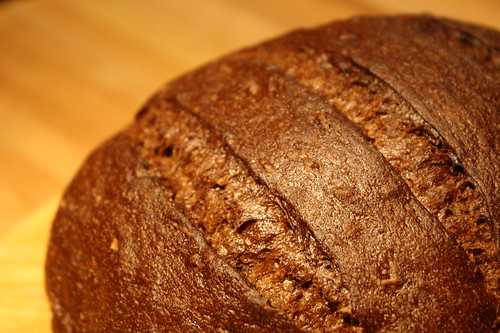Sunday Baking

Sundays are a day of rest at our farm. It’s a time when we leave most hard core jobs for another day. Whether we consider it the end of a week or just the beginning the pace is slower and more relaxed, with time to stroll in the garden and soak up some sun.
Sunday is also the day I bake my weekly bread. It’s a ritual I enjoy and one that lends itself well to a day of puttering. The weather is chilly and gloomy out there, a sharp contrast to the gardening-inducing sun of previous days. It is warm inside and the quiet melodic tunes coming from the radio seem to keep time with my wooden spoon moving around the bowl. I don’t know the name of the song, I don’t bother to pay attention to such mundane things on days l like this, but it a grand way to pass an afternoon. Grand indeed. Heat up the tea pot, kick off my shoes, cradle a newborn chick in my hands and breathe a little slower. Everyone has their own way of celebrating their faith. This is mine. A time when time itself seems to almost stand still, where songs sink deep into the soul reminding us of life’s more important meanings, where the food is good and a cup of tea puts a life on the mend. Life is good. Have a soulful day, all.
Buttermilk Whole Wheat Bread
(from Bernard Clayton’s New Complete Book of Breads)
(makes one 9″x5″ or two 8.5″x4.5″ loaves)
Ingredients:
2 packages dry yeast
3/4 cup warm water (105-115F)
1-1/4 cups buttermilk, room temperature
1-1/2 cups bread flour, approximately
3 cups whole wheat flour
1/4 cup shortening, room temperature
2 tablespoons brown sugar or molasses
2 teaspoons baking powder
2 teaspoons salt
Step 1 – In a large mixing bowl sprinkle the yeast over the warm water and stir briefly to dissolve. Set aside while allowing the buttermilk to reach room temperature, about 15 minutes.
Step 2 – When at room temperature, pour the buttermilk, bread flour, 1 cup whole wheat flour, shortening, brown sugar or molasses, baking powder, and salt into the yeast mixture. Blend with 50 strong strokes of a wooden spoon, or at low speed in a mixer until the flour and the dry ingredients are absorbed. With a wooden spoon or mixer flat beater stir in the remaining whole wheat flour, 1/2 cup at a time, and, when it becomes thick, work with the fingers. Allow 4 to 5 minutes for the whole wheat flour to fully absorb the liquid before adding more flour. The dough will be slightly sticky and soft. You may wish to add more bread flour to help control the stickiness.
Step 3 – Sprinkle flour on the work surface and turn out the soft dough. In the early stages of kneading, a metal spatula or dough blade will help turn and fold the dough. It will also scrape up the film of dough from the work surface. Knead with a strong push-turn-fold action, occasionally lifting the dough above the counter and banging it down hard. Knead for 8 minutes, buy hand or with a dough hook.
Step 4 – There is no “first” rising–the dough is put in the pans and set aside to rise. Divide the 2 pieces, if desired, and allow to rest for 5 minutes. Shape into balls; press the balls into ovals the length of the pans. Fold in half lengthwise, pinch the seam, and place in the pans with the seam under. Push the dough into the corners of the pans. Cover the pans with wax paper and leave at room temperature until the dough has risen 1″ to 2″ above the level of the pan, about 50 minutes. (Rising times will be reduced if using instant yeast.)
Step 5 – Preheat oven to 425F 20 minutes before baking.
Step 6 – Bake the loaf or loaves in the oven until they are golden brown and loose in the pans, about 30-35 minutes. Cover with foil if the crusts are browning too rapidly. The loaves are baked if the sound is hard and hollow when thumped on the bottom crust.
Step 7 – Remove loaves from the oven and place on wire racks to cool.
Recent comments
Aenean nonummy hendrerit mauris. Phasellus porta.